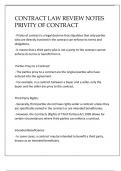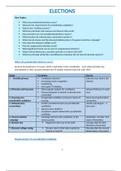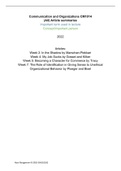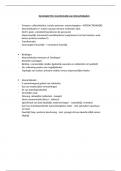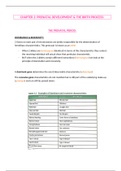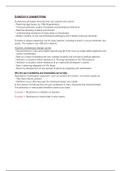Chapter 14: Energy Conversion: Mitochondria and Chloroplasts
energy-converting organelles:
o mitochondria produce ATP by oxidative phosphorylation
o chloroplasts harness solar energy to produce ATP by photosynthesis
occur only in plants and green algae
chemiosmotic coupling signifies a link between the chemical bond-forming
reactions that generate ATP (“chemi”) and membrane transport processes (“osmotic”)
o stage 1: energy from sunlight/food is
captured to generate an
electrochemical
proton gradient
across a membrane
o stage 2: ATP
synthase embedded
in the lipid bilayer of a
membrane harnesses
the electrochemical proton gradient across the membrane,
using it as a local energy store to drive ATP synthesis
NAD = electron carries takes up two electrons and one H+
+
NADH
two photosystems
Both mitochondria and chloroplasts make use of an electron-transfer chain to
produce an H+ gradient that powers reactions that are critical for the cell
The mitochondrion
Mitochondria are remarkably dynamic and plastic, moving about the cell, constantly
changing shape, dividing, and fusing
o are often associated with the microtubular cytoskeleton
o pyruvate is imported into the mitochondrion and ultimately oxidized by O2 to
CO2 and H2O ATP
Interaction between mitochondria and endoplasmic reticulum
inner membrane surrounds internal mitochondrial matrix
o folded to form invaginations known as cristae
crista space – crista membrane is continuous with inner boundary
membrane
crista junctions = narrow membrane tubes or slits; formed where their
membranes join
, o inner boundary membrane
o intermembrane space
outer mitochondrial membrane freely permeable to ions and to small molecules
as large as 5000 daltons
Inner mitochondrial membrane
contain the machinery for electron
transport and ATP synthesis
Inner mitochondrial membrane is a
diffusion barrier to ions and small
molecules
o selected ions, most notably
protons and phosphate, as well
as essential metabolites such as
ATP and ADP, can pass through
it by means of special transport
proteins
o protein complexes of the
respiratory chain =
mitochondrion’s electron-
transport chain
Energy-converting metabolism in
mitochondria
o chemiosmotic coupling
Mitochondria have many essential roles in cellular metabolism:
o critical for buffering the redox potential in the cytosol
shuttle system for NADH electrons
pentose phosphate pathway is an alternative to glycolysis
o Two critical steps of the urea cycle are carried out In the mitochondria of liver
cells, while the remaining steps occur in the cytosol
o play essential part in the metabolic adaptation of cells to different nutritional
conditions
o biosynthesis of heme groups
o iron-sulfer clusters are produced in mitochondria
o have central role in membrane biosynthesis
o major source of phospholipids for the biogenesis of other cell membranes
energy-converting organelles:
o mitochondria produce ATP by oxidative phosphorylation
o chloroplasts harness solar energy to produce ATP by photosynthesis
occur only in plants and green algae
chemiosmotic coupling signifies a link between the chemical bond-forming
reactions that generate ATP (“chemi”) and membrane transport processes (“osmotic”)
o stage 1: energy from sunlight/food is
captured to generate an
electrochemical
proton gradient
across a membrane
o stage 2: ATP
synthase embedded
in the lipid bilayer of a
membrane harnesses
the electrochemical proton gradient across the membrane,
using it as a local energy store to drive ATP synthesis
NAD = electron carries takes up two electrons and one H+
+
NADH
two photosystems
Both mitochondria and chloroplasts make use of an electron-transfer chain to
produce an H+ gradient that powers reactions that are critical for the cell
The mitochondrion
Mitochondria are remarkably dynamic and plastic, moving about the cell, constantly
changing shape, dividing, and fusing
o are often associated with the microtubular cytoskeleton
o pyruvate is imported into the mitochondrion and ultimately oxidized by O2 to
CO2 and H2O ATP
Interaction between mitochondria and endoplasmic reticulum
inner membrane surrounds internal mitochondrial matrix
o folded to form invaginations known as cristae
crista space – crista membrane is continuous with inner boundary
membrane
crista junctions = narrow membrane tubes or slits; formed where their
membranes join
, o inner boundary membrane
o intermembrane space
outer mitochondrial membrane freely permeable to ions and to small molecules
as large as 5000 daltons
Inner mitochondrial membrane
contain the machinery for electron
transport and ATP synthesis
Inner mitochondrial membrane is a
diffusion barrier to ions and small
molecules
o selected ions, most notably
protons and phosphate, as well
as essential metabolites such as
ATP and ADP, can pass through
it by means of special transport
proteins
o protein complexes of the
respiratory chain =
mitochondrion’s electron-
transport chain
Energy-converting metabolism in
mitochondria
o chemiosmotic coupling
Mitochondria have many essential roles in cellular metabolism:
o critical for buffering the redox potential in the cytosol
shuttle system for NADH electrons
pentose phosphate pathway is an alternative to glycolysis
o Two critical steps of the urea cycle are carried out In the mitochondria of liver
cells, while the remaining steps occur in the cytosol
o play essential part in the metabolic adaptation of cells to different nutritional
conditions
o biosynthesis of heme groups
o iron-sulfer clusters are produced in mitochondria
o have central role in membrane biosynthesis
o major source of phospholipids for the biogenesis of other cell membranes



